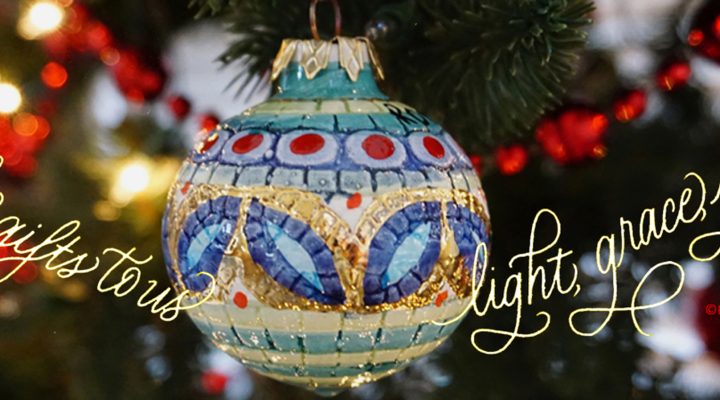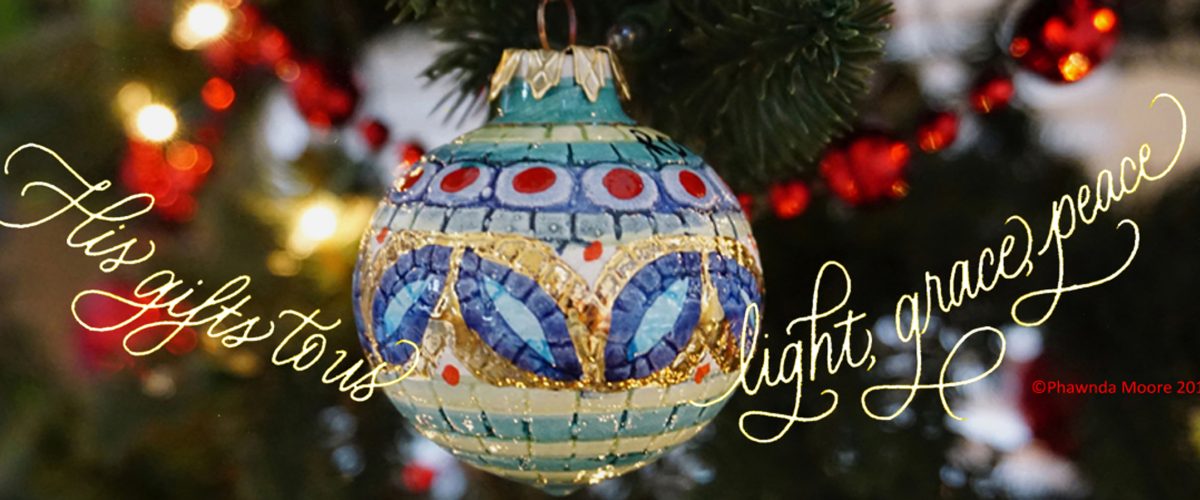Can you imagine this season without light? Light is the essence of Christmas, illuminating the birth of Christ and drawing us into its message of hope, love, peace and joy.
It’s no surprise that light is in many holiday traditions: a shining star atop a decorated tree; candles for Advent; and surrounding shepherds, wise men and Mary and Joseph gathered around the baby Jesus. Inside homes, the flames of the fireplace warm us and outdoors, LED lights project a mystical glow of holiday color.

Phawnda Moore
All over the world, believers and seekers respond to the joy of beautiful, dazzling Christmas displays. I’m in awe of the creativity and planning of these, shown here in the United States: gardens, churches, zoos, neighborhoods and caverns. You can take a train ride, enjoy hot cocoa, and hear live music in festive activities.
Seeing these displays ignites wonder. “Wonder,” says theologian, author and poet Eugene Peterson, “is the only adequate launching pad for exploring this fullness, this wholeness, of human life.”
But what if the light of the season is hidden beneath a heavy cloud of worry, grief, anger, numbness? Some are living through the darkest years of their life and ask how Christmas will make their lives any better.
Native American Episcopal priest Steven Charleston likens this darkness to being in a kiva. He recalled speaking to an audience of comfortable professionals who had lost confidence in political, judicial, health care or religious institutions. When asked, they could not cite any resources that would work to restore their sense of security.
“It is at this moment that faith becomes our compass, for it reminds us that darkness is only a detour, never a destination,” he said. Charleston sees the kiva (an underground room used for spiritual ceremonies) as a powerful vision for this time “because it arises from a wisdom more ancient than time itself. “
Near Albuquerque, N.M., we visited a kiva a few years ago. Everyone in our group was invited to climb down the ladder into darkness with “three parts of your body touching the ladder at all times for balance: either two hands and one foot or two feet and one hand.” When safely there, we gathered for a short time before returning to the light.
Charleston says the ladder is a metaphor to “call us to be a new light for one another, to form community, to work together, to share a common love that transforms reality and promotes justice … (to) see ourselves as the tribe of human beings, a community still in the kiva, waiting to be born.”
“Our truest response to the irrationality of the world is to paint or sing or write, for only in such response do we find truth.”
The Spirit shows us the way, offering assurance about the mysteries of the incarnation. I often gaze at the night sky to imagine it all or create something to bring the meaning into my heart. “Our truest response to the irrationality of the world is to paint or sing or write, for only in such response do we find truth,” wrote Madeleine L’Engle.
She wrote that, “A book, too, can be a star, explosive material, capable of stirring up fresh life endlessly, a living fire to lighten the darkness, leading out into the expanding universe.”
One of her many books, Bright Evening Star, is near our Christmas tree. Amazingly, each holiday the words are fresh and authentic, as is L’Engle: “Like it or not, we either add to the darkness of indifference and out-and-out evil which surrounds us or we light a candle to see by.”
L’Engle’s perspectives have been likened to C.S. Lewis, both contemplative mystics ahead of their time.
She confronted contemporary themes of sacred vs. secular, fact vs. fiction, truth vs. story, religion vs. art in her books. A Wrinkle in Time landed on the banned list and received the prestigious Newbery Medal from Association for Library Service to Children. Although her books were debated, few disputed that her faith guided her life.
Here are some of her quotes:
- Science never threatens God; it opens up more possibilities.
- Because we fail to listen to each other’s stories, we are becoming a fragmented human race.
- To try to talk about art and about Christianity is for me one and the same thing, and it means attempting to share the meaning of my life, what gives it, for me, its tragedy and its glory.
- I don’t understand it any more than you do, but one thing I’ve learned is that you don’t have to understand things for them to be.
- Poets are born knowing the language of angels.
- Sometimes when we aren’t looking, the holiness comes breaking through like a rainbow.
- I wish that we worried more about asking the right questions instead of being so hung up on finding answers.
- Truth is eternal. Knowledge is changeable. It is disastrous to confuse them.
In a 2018 book, A Light So Lovely, Sarah Arthur explores L’Engle’s life and work: L’Engle was willing to live “by paradox and contradiction and surprise. Through her relentless, generous, prolific art and her obvious love for Christ, Madeleine managed to challenge the narrow, reactionary, oddly unjoyful posture of some believers to the extraordinary world God made — and to the extraordinary God who made it. May her example inspire the church as it attempts to navigate a more generous and joyful path through the wilderness of this increasingly contentious world.”
Let us find wonder in this season in the sometimes dark, messy journey of life.
This is the irrational season
When love blooms bright and wild.
Had Mary been filled with reason
There’d have been no room for the child.
— Madeleine L’Engle in “After Annunciation”
Believe that today’s darkness is only a detour. May love bloom bright and wild in this irrational season, as we make room for the Child, Light of the World.
Wishing you a wonder-filled Christmas!
Phawnda Moore is a Northern California artist and award-winning author of Lettering from A to Z: 12 Styles & Awesome Projects for a Creative Life. In living a creative life, she shares spiritual insights from traveling, gardening and cooking. Find her on Facebook at Calligraphy & Design by Phawnda and on Instagram at phawnda.moore.
Related articles:
Angel wings and devil tails: Meditation on the Feast of the Holy Innocents | Opinion by Ken Sehested
What The Little Prince taught me about Christmas | Opinion by Phawnda Moore


